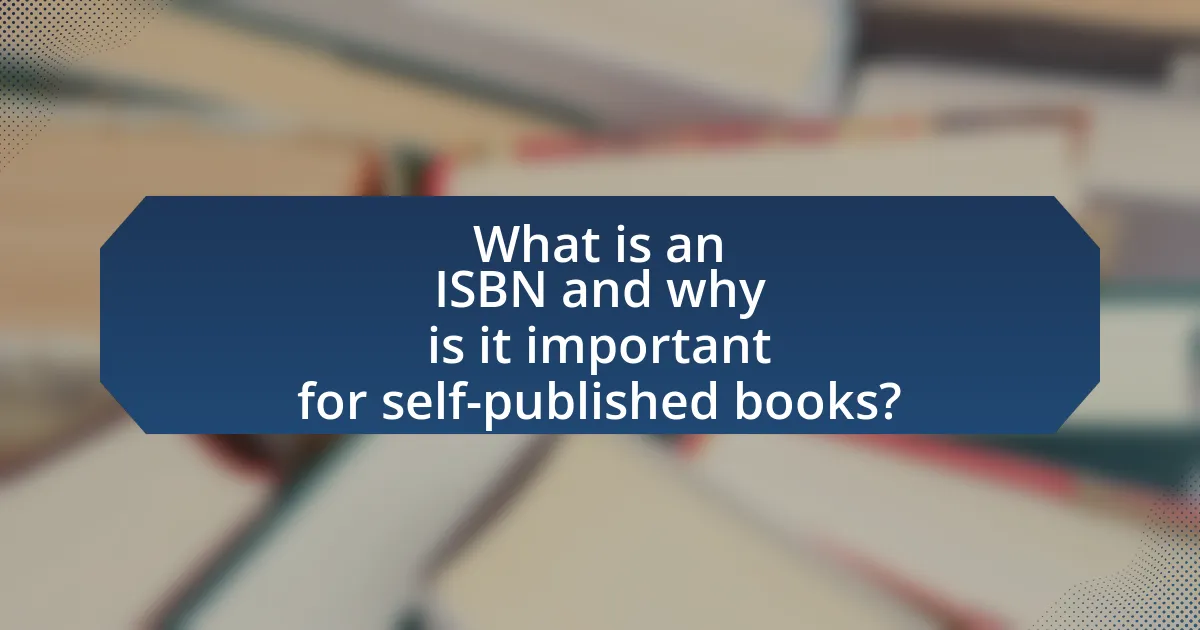The article focuses on the International Standard Book Number (ISBN), a crucial identifier for self-published books that enhances their distribution, visibility, and credibility in the marketplace. It explains the function of ISBNs in the publishing industry, detailing their components, types, and impact on book distribution. The article also outlines the process for obtaining an ISBN, including costs, registration, and best practices for usage, while emphasizing the importance of unique ISBNs for different book formats. Additionally, it addresses common mistakes to avoid and offers tips for maximizing the benefits of an ISBN to ensure effective sales tracking and discoverability.

What is an ISBN and why is it important for self-published books?
An ISBN, or International Standard Book Number, is a unique identifier for books that facilitates their distribution and sale. It is important for self-published books because it allows retailers, libraries, and distributors to easily locate and manage the book in their systems. Additionally, having an ISBN enhances the book’s credibility and visibility in the marketplace, as it is often required for listing on major online platforms and in catalogs. According to Bowker, the official ISBN agency in the United States, books with an ISBN are more likely to be sold and tracked effectively, making it a crucial element for self-published authors aiming for commercial success.
How does an ISBN function in the publishing industry?
An ISBN (International Standard Book Number) functions as a unique identifier for books in the publishing industry, enabling efficient cataloging and sales tracking. Each ISBN is specific to a particular edition of a book, which helps booksellers, libraries, and distributors manage inventory and sales accurately. The use of ISBNs facilitates the global distribution of books, as it standardizes the identification process across different markets and platforms. According to the International ISBN Agency, the system was introduced in 1970 and has since become essential for publishers to ensure their titles are easily discoverable and distinguishable in a crowded marketplace.
What are the key components of an ISBN?
The key components of an ISBN (International Standard Book Number) include the prefix element, registration group, registrant element, publication element, and check digit. The prefix element, typically “978” or “979,” identifies the book industry, while the registration group identifies the country or language area. The registrant element specifies the publisher, and the publication element identifies the specific title or edition of the book. Finally, the check digit is a single digit that validates the number’s accuracy through a mathematical formula. Each component plays a crucial role in ensuring that the ISBN uniquely identifies a book in the global marketplace.
How does an ISBN impact book distribution?
An ISBN significantly impacts book distribution by providing a unique identifier that facilitates the tracking and sales of books across various platforms. This unique number allows publishers, retailers, and libraries to efficiently manage inventory and sales data, ensuring that books can be easily ordered and located. According to Bowker, the official ISBN agency in the United States, over 80% of books sold in the U.S. are assigned an ISBN, highlighting its critical role in the distribution process. Without an ISBN, a book may struggle to gain visibility in retail and online marketplaces, limiting its reach and sales potential.
What are the different types of ISBNs available?
There are two main types of ISBNs available: the 10-digit ISBN and the 13-digit ISBN. The 10-digit ISBN was used until December 31, 2006, after which the 13-digit format became the standard. The 13-digit ISBN is now the internationally recognized format and is used for all new publications. The transition to the 13-digit format was implemented to accommodate the growing number of publications and to ensure a more efficient system for identifying books globally.
What distinguishes a 10-digit ISBN from a 13-digit ISBN?
A 10-digit ISBN is distinguished from a 13-digit ISBN primarily by its length and structure. The 10-digit ISBN, used until 2007, consists of four parts: the group identifier, publisher identifier, title identifier, and a check digit, while the 13-digit ISBN, adopted to expand the numbering system, includes a prefix (usually 978 or 979) followed by the same four parts as the 10-digit version. The transition to 13 digits was necessary to accommodate the growing number of publications and to align with the global EAN-13 barcode system, which allows for better inventory management and sales tracking.
When should you use an ISBN for different formats (e.g., eBook, paperback)?
An ISBN should be used for each distinct format of a book, including eBooks and paperbacks, to ensure proper identification and distribution. Each format requires a unique ISBN because they are treated as separate products in the marketplace, facilitating tracking, sales, and inventory management. For example, a paperback version and an eBook version of the same title will each need their own ISBN to differentiate them in retail systems and libraries. This practice is supported by the International ISBN Agency, which states that different formats or editions of a book must have different ISBNs to avoid confusion and ensure accurate sales reporting.
How does obtaining an ISBN benefit self-published authors?
Obtaining an ISBN benefits self-published authors by providing a unique identifier for their books, which facilitates distribution and sales tracking. This unique identifier allows retailers, libraries, and online platforms to catalog and sell the book efficiently. Furthermore, having an ISBN enhances the book’s credibility and professionalism, making it more appealing to potential readers and distributors. According to Bowker, the official ISBN agency in the United States, books with an ISBN are more likely to be stocked by retailers and libraries, as they can easily manage inventory and sales data.
What advantages does an ISBN provide in terms of sales tracking?
An ISBN provides significant advantages in sales tracking by enabling precise identification of books across various platforms and retailers. This unique identifier allows publishers and authors to monitor sales data effectively, as each ISBN corresponds to a specific title, format, and edition. Consequently, sales figures can be accurately aggregated and analyzed, facilitating better inventory management and marketing strategies. Furthermore, major retailers and distributors utilize ISBNs to streamline their sales reporting processes, ensuring that sales data is consistently tracked and reported back to publishers. This systematic approach to sales tracking enhances the ability to assess market performance and make informed business decisions.
How does an ISBN enhance a book’s credibility?
An ISBN enhances a book’s credibility by providing a unique identifier that distinguishes it from other publications. This unique number allows booksellers, libraries, and readers to easily locate and reference the specific title, thereby establishing a professional standard in the publishing industry. Furthermore, the presence of an ISBN signals to consumers that the book has undergone a formal publishing process, which often includes editorial review and quality control measures. According to Bowker, the official ISBN agency in the United States, books with ISBNs are more likely to be stocked by retailers and libraries, reinforcing their legitimacy and marketability.

How can you obtain an ISBN for your self-published book?
To obtain an ISBN for your self-published book, you can purchase one through your country’s designated ISBN agency. In the United States, for example, Bowker is the official agency that provides ISBNs, and authors can buy them directly from their website. Each ISBN is unique to a specific edition of a book, ensuring proper identification in the publishing industry. According to Bowker, self-published authors can acquire a single ISBN or a block of ten, which is often more cost-effective for those planning multiple titles.
What are the steps to acquire an ISBN?
To acquire an ISBN, follow these steps: First, determine the number of ISBNs needed based on the number of formats for your book (e.g., print, eBook). Next, visit the official ISBN agency website for your country, such as Bowker in the United States or Nielsen in the UK. Then, create an account and complete the application form, providing details about your book, including title, author, and publication date. After submitting the application, pay the required fee, which varies by agency and the number of ISBNs purchased. Finally, receive your ISBN(s) via email or through your account on the agency’s website, allowing you to assign them to your book formats.
Where can you purchase an ISBN?
You can purchase an ISBN from the official ISBN agency in your country, such as Bowker in the United States, which is the primary source for ISBNs. Bowker allows individuals and businesses to buy ISBNs directly through their website, providing a straightforward process for obtaining unique identifiers for self-published books. In addition, some online retailers and publishing platforms, like Amazon’s Kindle Direct Publishing and IngramSpark, offer ISBNs as part of their services, often bundled with other publishing tools.
What information do you need to provide when applying for an ISBN?
When applying for an ISBN, you need to provide the title of the book, the author’s name, the format of the book (e.g., paperback, hardcover, e-book), and the publisher’s name. This information is essential as it ensures that the ISBN is correctly assigned and linked to the specific publication. Additionally, you may need to include the publication date and the book’s intended market or audience, which helps in cataloging and distribution. These details are required by ISBN agencies to maintain accurate records and facilitate the identification of books in the marketplace.
How much does it cost to obtain an ISBN?
The cost to obtain an ISBN typically ranges from $125 to $295 in the United States, depending on the number of ISBNs purchased. For example, a single ISBN costs around $125, while purchasing a block of ten ISBNs can cost approximately $295. This pricing is set by Bowker, the official ISBN agency in the U.S., which has been the sole provider of ISBNs since 1970.
Are there any free options for obtaining an ISBN?
Yes, there are free options for obtaining an ISBN. Some self-publishing platforms, such as Amazon Kindle Direct Publishing and Smashwords, offer free ISBNs to authors who publish through their services. These platforms assign an ISBN at no cost, allowing authors to publish their books without the expense of purchasing an ISBN independently.
What are the pricing differences between purchasing single and multiple ISBNs?
Purchasing a single ISBN typically costs around $125, while buying multiple ISBNs significantly reduces the per-unit price, with a block of ten ISBNs costing approximately $295, resulting in a cost of about $29.50 each. This pricing structure incentivizes bulk purchases, as the cost per ISBN decreases with larger quantities, making it more economical for authors or publishers planning to release multiple titles.

How should you use an ISBN effectively for your self-published book?
To use an ISBN effectively for your self-published book, obtain a unique ISBN for each format of your book, such as print, eBook, and audiobook. This ensures that each version is easily identifiable and can be tracked by retailers and libraries. Additionally, register the ISBN with a reputable agency, like Bowker in the United States, to maintain ownership and facilitate distribution. Properly display the ISBN on the book’s copyright page and cover to enhance visibility and accessibility. According to Bowker, having an ISBN increases the chances of your book being found and sold, as it is essential for inventory management in bookstores and libraries.
What are the best practices for assigning ISBNs to your books?
The best practices for assigning ISBNs to your books include obtaining a unique ISBN for each format of your book, ensuring that the ISBN is registered with a reputable agency, and maintaining accurate metadata associated with the ISBN. Each format, such as paperback, hardcover, and e-book, requires a distinct ISBN to facilitate proper cataloging and sales tracking. The International Standard Book Number (ISBN) system is managed by organizations like Bowker in the United States, which provides a reliable source for purchasing and registering ISBNs. Accurate metadata, including title, author, and publication date, linked to the ISBN is crucial for discoverability and sales in retail and library systems.
How do you manage multiple ISBNs for different formats of the same book?
To manage multiple ISBNs for different formats of the same book, assign a unique ISBN to each format, such as hardcover, paperback, eBook, and audiobook. This practice ensures that each format is distinctly identified in the marketplace, facilitating inventory management and sales tracking. For example, the International Standard Book Number (ISBN) system requires that each version of a book, regardless of format, has its own ISBN to avoid confusion among retailers and libraries. This approach is supported by the ISBN Agency, which emphasizes the importance of unique identifiers for different formats to streamline distribution and sales processes.
What should you do if you need to change your book’s ISBN?
To change your book’s ISBN, you must obtain a new ISBN from the appropriate issuing agency, such as Bowker in the United States. This process involves applying for a new number, which is necessary because each ISBN is unique to a specific edition of a book. Once you have the new ISBN, update all relevant metadata, including your book’s listing on retail platforms and your own promotional materials, to reflect the change. This ensures that readers and retailers can accurately identify the correct version of your book.
What common mistakes should you avoid when using an ISBN?
Common mistakes to avoid when using an ISBN include using the same ISBN for different formats of a book, failing to register the ISBN with the appropriate agency, and neglecting to update the ISBN when significant changes are made to the book. Using one ISBN for multiple formats, such as paperback and eBook, can lead to confusion in distribution and sales tracking. Not registering the ISBN can result in lost sales opportunities, as retailers and libraries may not recognize the book. Additionally, failing to update the ISBN after revisions or new editions can mislead readers and retailers about the book’s content. These practices can hinder the book’s visibility and sales potential in the market.
How can incorrect ISBN usage affect your book’s sales?
Incorrect ISBN usage can significantly hinder a book’s sales by making it difficult for retailers and libraries to locate and stock the title. An ISBN serves as a unique identifier for books, and if it is incorrect, it can lead to confusion in inventory systems, resulting in missed sales opportunities. For instance, a study by Bowker, the official ISBN agency in the U.S., indicates that books without proper ISBNs are often not listed in major databases, which can limit visibility and accessibility to potential buyers. Consequently, incorrect ISBNs can lead to reduced discoverability, ultimately impacting overall sales performance.
What are the implications of not using an ISBN at all?
Not using an ISBN can severely limit a book’s marketability and accessibility. Without an ISBN, retailers and libraries may refuse to stock the book, as they rely on this unique identifier for inventory management and sales tracking. Additionally, the absence of an ISBN complicates distribution, making it difficult for authors to reach a wider audience through online platforms and bookstores. According to Bowker, the official ISBN agency in the United States, books without an ISBN are often considered less credible, which can deter potential readers and buyers.
What tips can help you maximize the benefits of your ISBN?
To maximize the benefits of your ISBN, ensure you obtain a unique ISBN for each format of your book, as this facilitates accurate tracking and sales reporting across different platforms. Additionally, register your ISBN with a reputable database, such as Bowker, to enhance discoverability and ensure that your book is easily found by retailers and libraries. Furthermore, include your ISBN in all marketing materials and on your book cover, as this promotes professionalism and aids in sales. Lastly, keep your ISBN information updated, especially if there are changes in the book’s title or author details, to maintain accurate records and avoid confusion in the marketplace.
How can you ensure your book is easily discoverable with an ISBN?
To ensure your book is easily discoverable with an ISBN, you must register the ISBN with a reputable agency and ensure it is included in all relevant databases. Registering the ISBN with an organization like Bowker in the United States or Nielsen in the UK guarantees that your book is listed in their databases, which are frequently accessed by retailers and libraries. Additionally, providing accurate metadata, including the book title, author name, genre, and keywords, enhances discoverability. According to Bowker, books with complete metadata are 30% more likely to be found by readers.
What resources are available for tracking your book’s performance using its ISBN?
Resources available for tracking your book’s performance using its ISBN include online platforms such as Nielsen BookScan, which provides sales data for books sold in the U.S. and the U.K., and Bowker’s Books in Print, which offers comprehensive bibliographic information and sales tracking. Additionally, Amazon Author Central allows authors to monitor their book’s sales rank and performance metrics. These resources utilize the ISBN to aggregate and report data, enabling authors to analyze their book’s market performance effectively.




